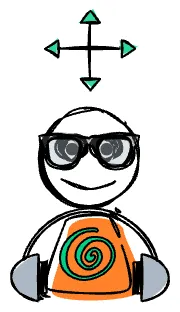The Energetics of Stress
Stress: An applied force, or system of forces, that tend to strain or deform a body (mental, physical, emotional, etc.)
The word stress comes from the word 'strict' -- meaning 'complete, absolute, maintained without exception or deviation'.
And the word strict comes from the root word 'strictus' -- meaning 'to draw tight, tighten'.
“We can think of stress as a constriction”
Stress can be viewed as a constriction of mental and emotional resources.
When faced with stressors, individuals often experience a narrowing of focus (can't see the bigger picture )and a tightening of emotional bandwidth (leading to Reactions vs Response), all of which can lead to feelings of being overwhelmed or trapped.
This constriction limits one's ability to think creatively or respond flexibly to challenges, akin to a bottleneck that restricts the flow of ideas and emotions.

"Can you get a sense of this 'constriction'? Can you feel it?
What would it feel like to experience the OPPOSITE of this?"
In engineering, stress refers to the internal forces within a material that arise when it is subjected to external forces or loads.
This concept can be directly related to the human experience of stress, where external pressures (such as work demands, personal challenges, or environmental factors) create internal tension within an individual.
Just as materials can deform or fail when subjected to excessive stress, humans can experience psychological or physical breakdowns when their capacity to cope is exceeded.
The engineering principle of stress involves understanding how materials can withstand forces without breaking, which parallels the need for resilience and adaptability in managing personal stress.
Stress and Constriction
The derivation (where the word came from) of the word stress from 'strictus' highlights its constrictive nature.
In both human and engineering contexts, stress involves a tightening or restriction that can lead to potential failure if not managed properly.
This constriction can manifest as:
1. Cognitive Narrowing: Under stress, individuals may find it difficult to see the bigger picture or consider alternative solutions, similar to how a material under stress may lose flexibility.
2. Emotional Tightening: Stress can lead to heightened emotions, such as anxiety or irritability, which constrict one's ability to remain calm and composed.
3. Physical Tension: Just as materials experience physical deformation under stress, humans can experience physical symptoms like muscle tension or headaches.
Stress, Anxiety and Depression
Stress can often lead to anxiety, and if left unchecked, depression.
From an energetic point of view we can look at it as:
Constriction (Stress) >> Twisting (Anxiety) >> Discharge (Nervous System) >> Shut Down (Depression)
(PLEASE SEE 'The Energetics of Anxiety' and 'The Energetics of Depression' for a fuller understanding)
What Can We Do...
Looking at it from an 'energetic perspective' -- we can:
Loosen the twist (release / unwind)
Reverse the pattern (balance)
Reduce the counterforce (reaction to response)
Increase flow in desired direction (intentional thoughts)
Apply adaptive measures = reengineer (identity)
This is the essence of DSA -- once you can 'See' (mind) and 'Feel' (body) the nature of your problem, you can apply it's opposite to return to a Neutral State.
Then, when you're ready, you can start to imagine and engage with a new potential state.
This can all be done energetically, using our mind to guide the changes needed, while our body’s natural receptive centres allow us to feel if and when change is occurring.
But, in order to know if a change has occurred, we must first know what we are dealing with.
We have to know who, what and where we are — before we can know who, what and where we want to be.
